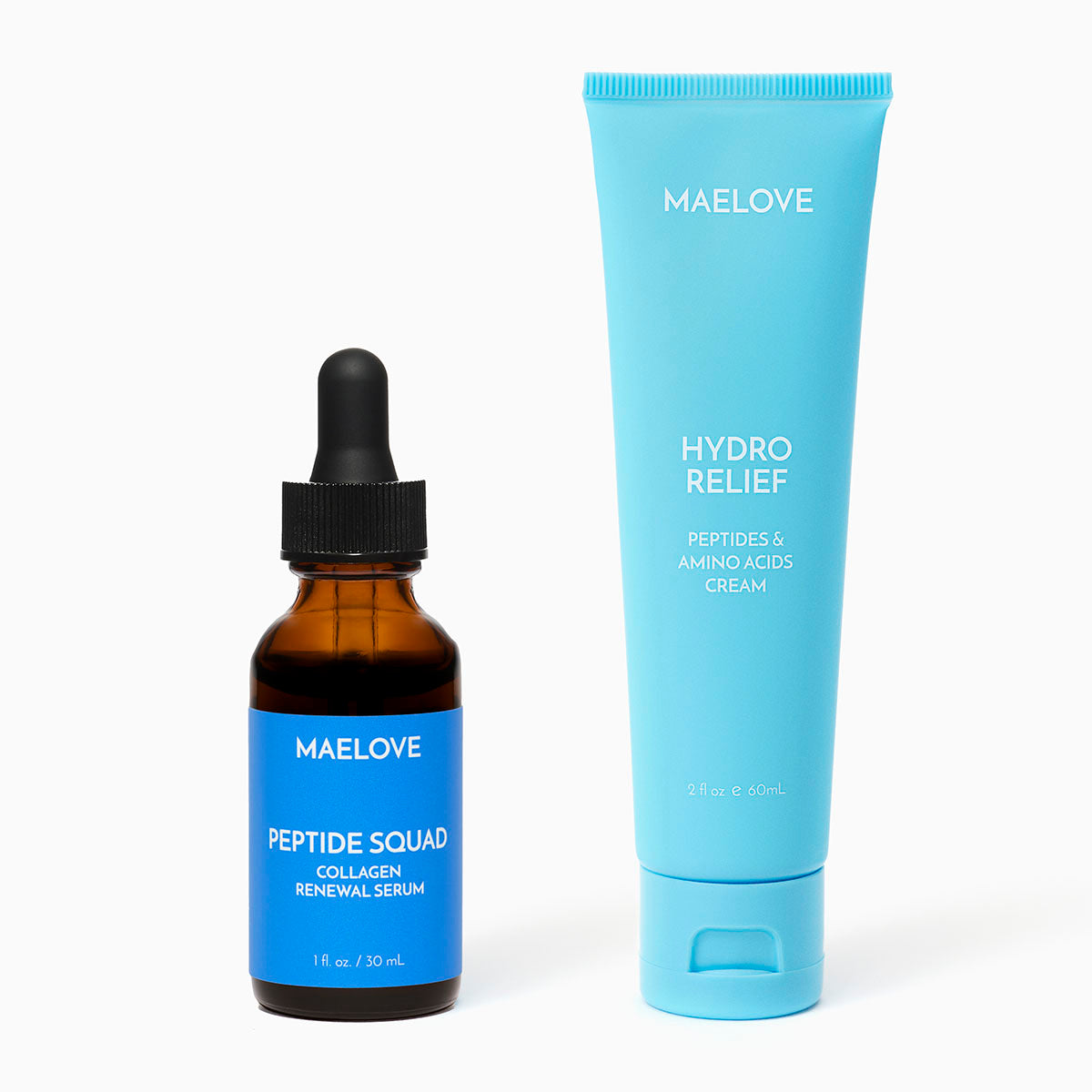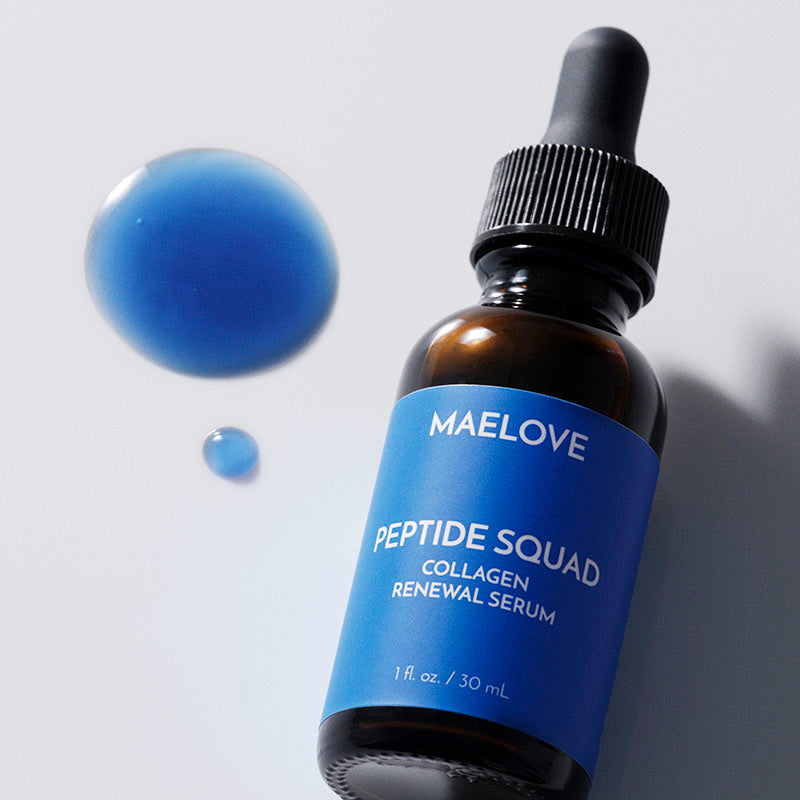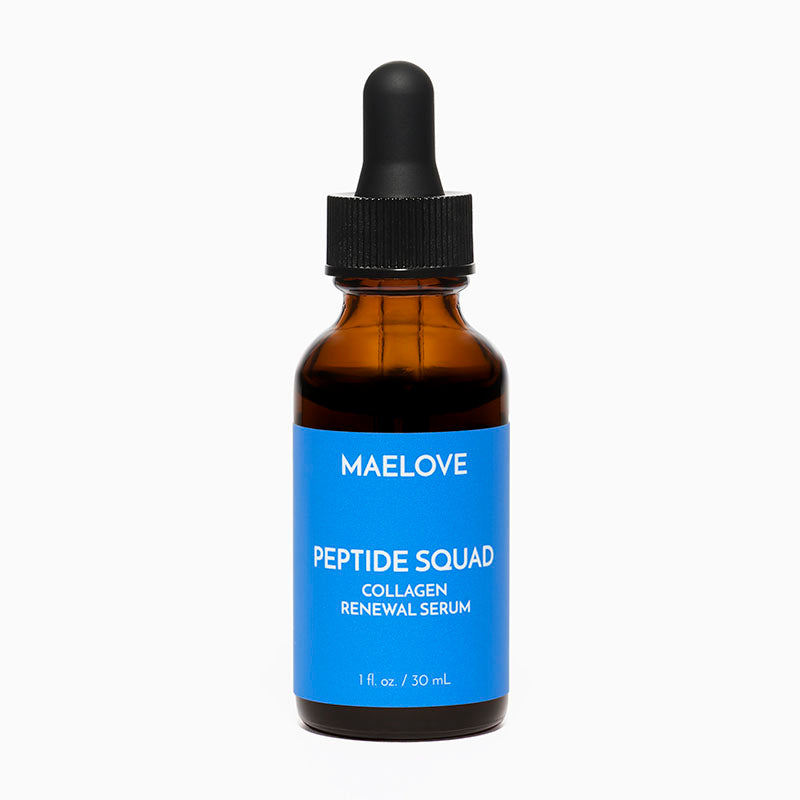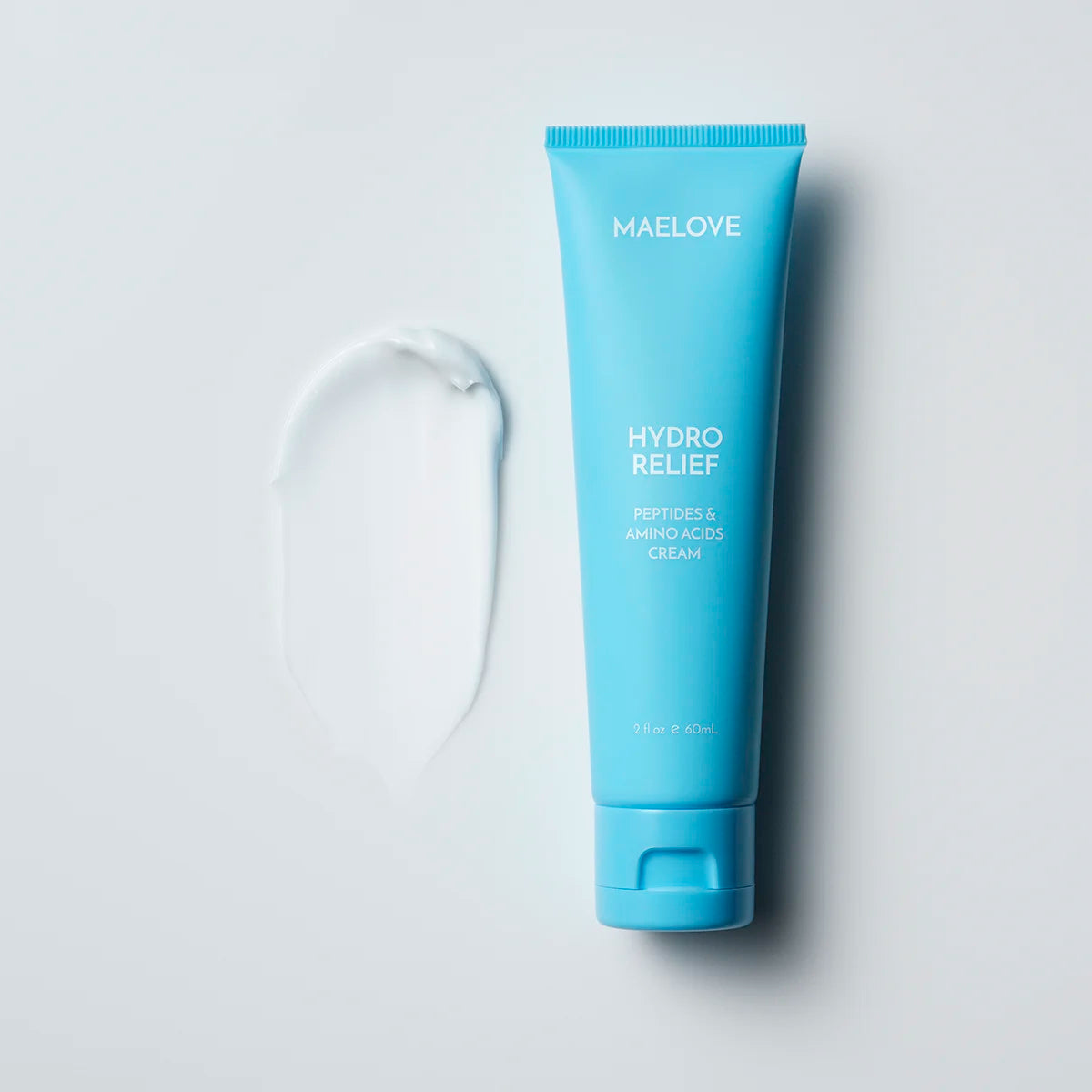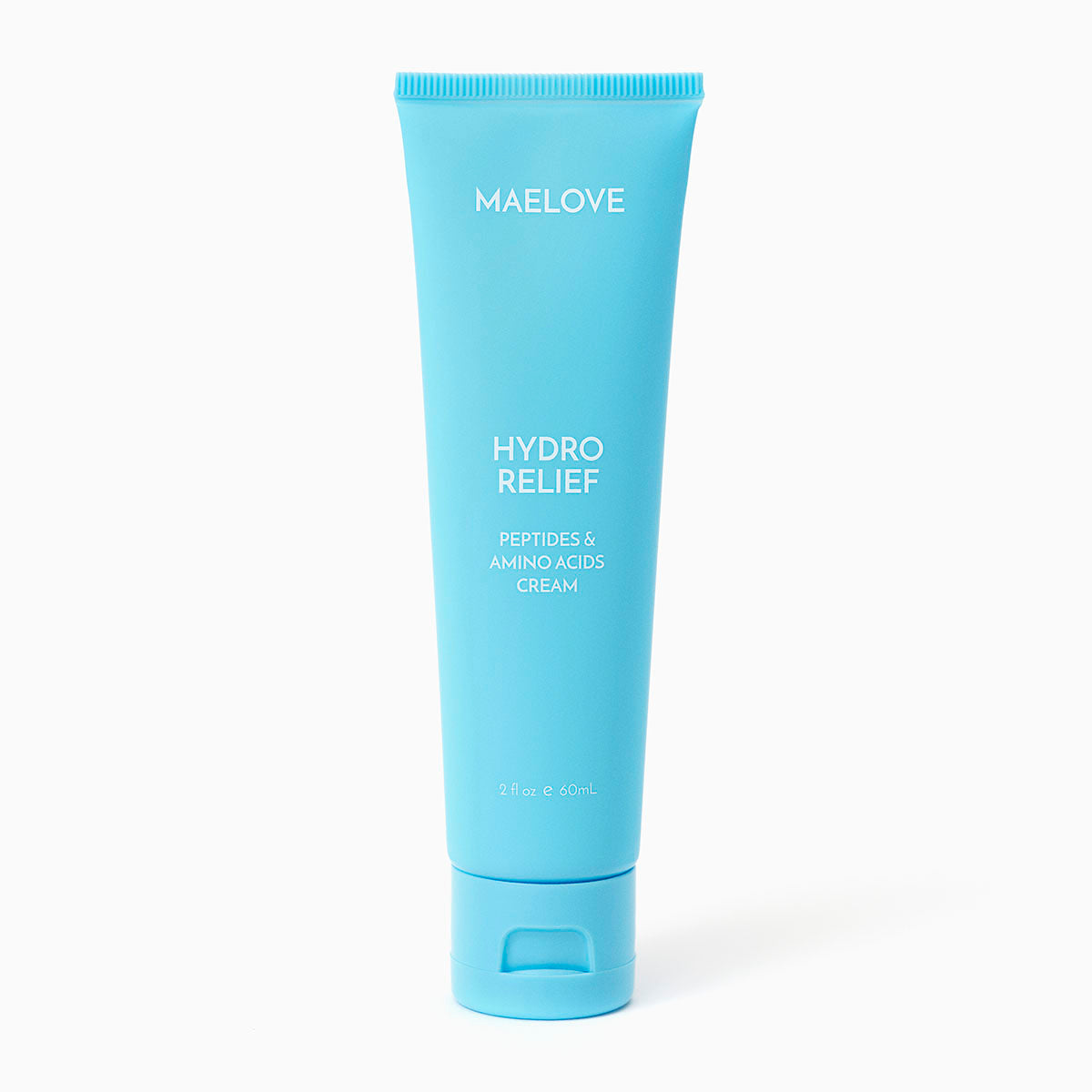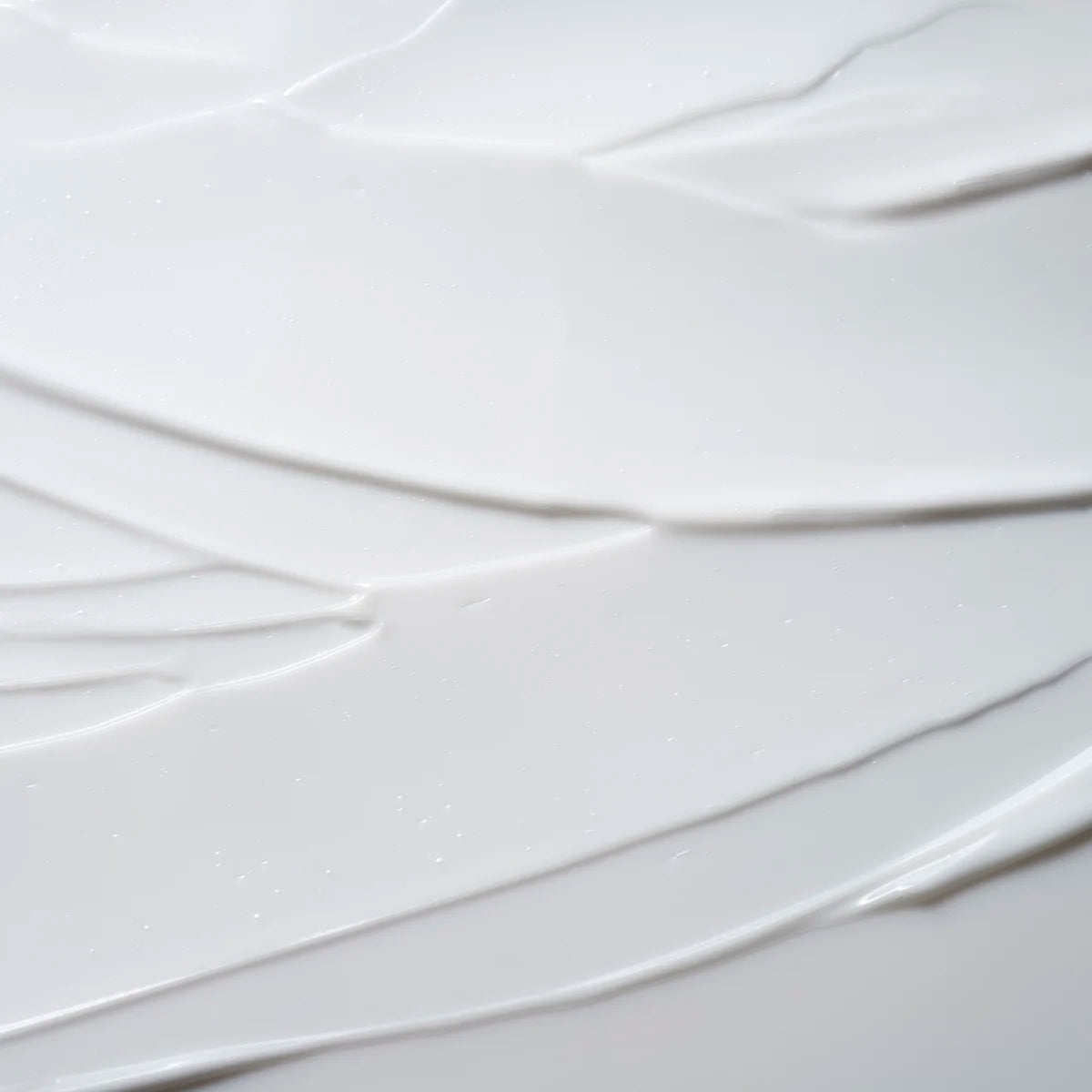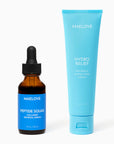

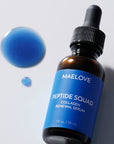
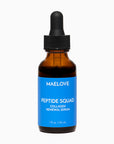
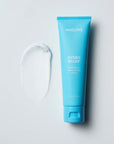
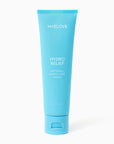
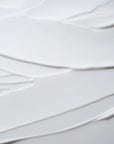
Powered by Peptides Duo
Peptide Squad Collagen Renewal Serum
The first serum on the market featuring all four classes of peptides, uniquely designed to combat signs of aging from every angle while boosting collagen production and improving the skin barrier.
Hydro Relief Peptides & Amino Acids Cream
Seal in your serums with a deeply nourishing, gentle moisturizer that locks in hydration and calms skin without clogging pores or leaving a greasy residue. This rich cream can be used by all skin types, but is especially helpful for dry skin, signs of aging, and in cold or dry climates.
We firmly stand behind the efficacy of our products, which is why we back them with an industry-leading 100-day Money Back Guarantee.
If you're not 100% happy, return the products within 100 days for a full refund. We'll even cover the return shipping. It's our commitment to ensure that you're completely satisfied with your Maelove journey.
Introducing
Powered By Peptide Duo
Obsessively Formulated
Peptide Squad Serum - Peptide Squad is meticulously formulated with all four types of science-backed peptides: Copper tripeptide (GHK-Cu) delivers vital copper for collagen synthesis, while Matrixyl 3000 stimulates collagen production. Argireline reduces expression lines, and rice peptides slow collagen breakdown.
This naturally blue serum is boosted with a blend of nourishing, skin-barrier supporting ingredients to further hydrate and calm skin.
Hydro Relief Cream - Ideal for layering after serums, Hydro Relief is a quick-absorbing, non-comedogenic daily moisturizer enriched with soy peptides and rice amino acids to mimic natural moisturizing factors in the skin while correcting signs of aging.
We combined these humectants with plant-based lipids like squalane, shea butter, and jojoba esters to lock in hydration with a luxurious, non-greasy feel on the skin.
Peptide Squad is uniquely formulated with all four categories of wrinkle-fighting peptides
- Copper peptides (GHK-Cu) are a carrier peptide that helps build collagen
- Argireline is a neurotransmitter-inhibiting peptide that relaxes facial muscles to reduce expression lines
- Matrixyl 3000 is a signal peptide that boosts collagen production for firmer skin
- Rice peptides are an enzyme-inhibitor peptide that prevents collagen breakdown
Peptides and plant-based lipids in Hydro Relief further hydrate and plump the skin
- Rice amino acids and soy peptides replenish moisture levels for a smoother complexion
- Anti-aging properties diminish fine lines and wrinkles for a more youthful appearance
- Squalane, shea butter, and jojoba esters form a protective barrier on the skin to seal in moisture
For AM and/or PM. Apply a thin layer of Peptide Squad serum to the face, neck, and chest. Massage product in until it is fully absorbed. Follow with Hydro Relief cream to lock in the serum.
Layer your products from thinnest to thickest in texture, waiting a full minute between each product.
Peptide Squad
Key Ingredients
Matrixyl 3000 (Palmitoyl tripeptide-1, palmitoyl tripeptide-7) - signal peptides that increase collagen production
Argireline (acetyl-hexapeptide-8) - neurotransmitter-inhibiting peptide that inhibits movement based expression lines
Copper peptides GHK-Cu (copper tripeptide-1) - carrier peptide that helps build collagen
Rice peptides - enzyme inhibitor peptide that inhibit collagen breakdown
Supporting Ingredients
Hyaluronic acid, Aloe, Vitis Vinifera, Magnolia, and Aurantium Dulcis Extract, Niacinamide, panthenol, hyaluronic acid, natural moisturizing factors, ceramides, jojoba oil, and botanical extracts and actives including allantoin, aloe, green tea, turmeric, red algae and polyphenols madecassoside (found in CICA) and bisabolol (found in chamomile)
Hydro Relief
Key Ingredients
Soy peptides - natural moisturizing factors that are also anti-aging
Oryza Sativa (Rice) Bran extract - natural moisturizing factors that are anti-aging and help even skin tone
Rice amino acids - natural moisturizing factors that help even skin tone
Shea Butter - emollient occlusive from nut of African Shea tree can incorporate into the skin barrier
Squalane - plant-derived version of a natural lipid found in skin that helps “water-proof” the skin
Jojoba Esters - plant-derived wax from Jojoba shrub with performance on par with petroleum
Supporting Ingredients
Niacinamide, Panthenol, Green Tea extract, Rosemary extract
All Maelove products are safe for sensitive skin, made in the US, vegan, cruelty-free, non-comedogenic, gluten-free, and free of parabens, phthalates, dyes, and artificial fragrances. We don't use ingredients that are banned in the EU or in the USA.
Show all ingredients
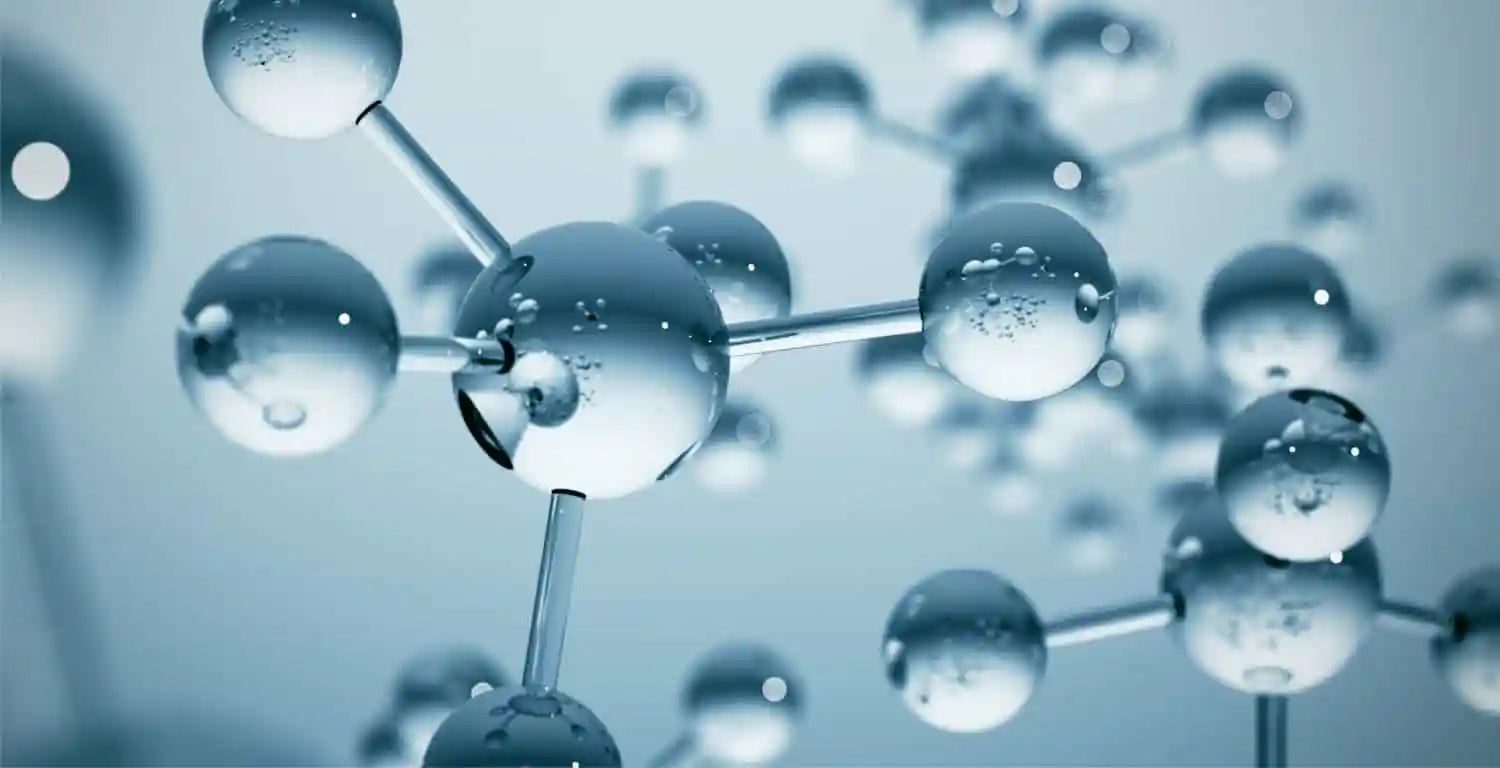
Peptides are the new buzzwords on the face of numerous serums, each claiming transformative benefits. How do you decide if they will do something for you? Let’s unravel the so-called...
For the Curious
The four classes include signal peptides (aka Matricin or Matrikine peptides), neurotransmitter inhibiting peptides, carrier peptides, and enzyme inhibiting peptides. Peptides are classified by the mechanisms by which they are known to fight wrinkles (Gorouhi and Maibach 2009, Ferreira et al. 2020, Schagen et al. 2017). By combining all four classes of peptides, Peptide Squad employs a multifactorial approach to fighting wrinkles and targeting the signs of aging from different angles. This approach can create synergies and leads to better results. Hydro Relief contains additional enzyme inhibitor peptides.
Signal peptides are also known as Matricin or Matrikine peptides and specifically refer to collagen or extracellular matrix (ECM) fragments which improve wrinkles and skin hydration by signaling fibroblasts to increase the production of collagen, elastin, glycosaminoglycans (GAGs) such as hyaluronic acid, and other components of the ECM including proteoglycans, fibronectin and laminin (Errante et al. 2020, Gorouhi and Maibach 2009).
Matrixyl 3000 is a patented combination of two signal peptides (pal-GHK and pal-GQPR, aka palmitoyl tripeptide-7 and palmitoyl tripeptide-1) which have known synergy with one another as first demonstrated in in-vitro studies with dermal fibroblasts (fibroblasts secrete collagen, elastin, and other ECM components in the dermal layer of the skin) (US patent 2004/0132667 A1). In these studies, the combination of pal-GHK and pal-GQPR was more effective at stimulating collagen type 1, fibronectin and hyaluronic acid than either peptide alone.
Subsequent placebo controlled clinical studies in both men and women showed that a cream containing Matrixyl 3000 significantly decreased wrinkle depth and volume as well as skin roughness. In the first clinical study in older women, Matrixyl 3000 cream was applied on half the face versus placebo on the other half for crow’s feet wrinkles. With Matrixyl 3000, they found a significant 23.3% decrease in wrinkle volume, a 19.9% decrease in wrinkle depth and 16% decrease in roughness compared to baseline but no benefit with placebo. In the second clinical study in older men, Matrixyl 3000 cream gel was applied on half the face versus placebo on the other half on crow’s feet wrinkles. With Matrixyl 3000, they found a significant 17.1% decrease in wrinkle volume and 10.2% decrease in wrinkle depth and 8.4% decrease in roughness compared to baseline but no benefit with placebo (Sederma Matrixyl 3000).
A final clinical study was conducted to image changes of the papillary dermis. As described in a follow-up US patent 2012/164488, Sederma conducted a double-blind, placebo-controlled clinical study in 28 women who applied Matrixyl 3000 on half the face and placebo on the other half for 2 months and found an improvement in dermal density and reduced fragmentation in the collagen fibers of the dermis with Matrixyl 3000 compared to placebo (Sederma Matrixyl 3000).
On their own, pal-GHK and pal-GQPR also represent two of the best studied signal peptides. As characteristic of signal peptides, GHK and GQPR are fragments of proteins found naturally in the human body that are involved in ECM remodeling particularly during wound healing. GHK is a fragment of the alpha 2 chain of type I collagen while GQPR is a fragment of immunoglobin G. By linking each of these peptides to a palmitoyl group (and hence the pal-), these peptides become lipophilic. In other words, being lipophilic, they can cross the stratum corneum, the waterproof outer layer of the skin barrier, and can be absorbed into the deeper layers of the skin where they have their action.
GHK was first isolated from human plasma in 1973 (Pickart and Thaler 1973) and its wound repair properties were first observed in 1985 by Maquart and colleagues who found GHK was a potent activator of ECM synthesis and remodeling (Maquart et al. 1999). GHK has been found since then to have multiple biological actions improving tissue repair in skin, lung connective tissue, boney tissue, liver, and stomach lining. It has a wide range of effects on gene expression (Pickart and Margolina 2018). When damage activates proteolytic enzymes, GHK is released into the site of injury. GHK can stimulate skin dermal fibroblasts to produce growth factors and increase collagen synthesis and epidermal basal cells increasing integrins and p63 expression (Pickart and Margolina 2018, Lintner 2002).
GHK content is highest in the young with plasma levels at about ~200ng/ml at age 20 which declines to ~80ng/ml at age 60. This natural decline with aging may in part explain why adding peptides back to the skin can reverse signs of aging. GHK has been used in anti-aging and cosmetic products in humans for decades without any adverse effects and so has an established safety record (Pickart and Margolina 2018). Even without co-formulation with pal-GQPR, pal-GHK can increase collagen and GAG synthesis as well as improve collagen repair (Sederma Matrixyl 3000).
There is some misinformation on the web that states signal peptides such as GHK that are involved in wound healing have negative effects such as increasing inflammation because they mimic wounds. This is untrue as GHK has proven anti-inflammatory and antioxidant activity. GHK has anti-inflammatory benefits by reducing TNF-alpha induced secretion of proinflammatory cytokine IL-6 in dermal fibroblasts, and GHK is an efficient antioxidant, inactivating damaging free radical by-products of lipid peroxidation (Pickart et al. 2015, Pickart and Margolina 2018).
Pal-GQPR has also been studied and used separately from pal-GHK for many years in both skin and eye creams. GQPR is a fragment of immunoglobin G which is immunomodulatory. As skin ages, there is an increase in inflammatory cytokine IL-6, which may contribute to chronic inflammation in the aging process. The putative mechanism by which Pal-GQPR works is by reducing IL-6 secretion by keratinocytes. However, like GHK, GQPR changes the expression of multiple genes and so it has a broad effect on fibroblast activity that goes beyond anti-inflammatory action. Studies by Sederma show that pal-GQPR and pal-GHK activate complementary genes explaining the synergy between the two peptides (Sederma Matrixyl 3000).
Neurotransmitter inhibiting peptides are sometimes informally called “botox-like” or a botox alternative, though this descriptor is disliked by dermatologists. Nonetheless, the principles behind these peptides are similar to that of botox in that they aim to act on the cholinergic neuromuscular junction to inhibit muscle activity and in this manner, limit wrinkle formation. For neurotransmitter acetylcholine to be released, a reaction cascade mediated by SNAP receptor proteins and SNARE complex formation is necessary. SNAP-25 specifically is targeted by both botulinum neurotoxin type A (botox) and the peptide included here, ArgirelineR. ArgirelineR competes with the SNARE complex by mimicking the N terminal end of SNAP-25 – hence preventing formation of the SNARE protein complex and inhibiting acetylcholine release and subsequent muscle contraction (Lipotec Argireline).
Argireline (also known as acetyl hexapeptide-8 or acetyl hexapeptide-3) has been shown to have an anti-wrinkle effect (Blanes-Mira et al. 2002, Draelos et al 2016). It has lower efficacy than botox itself but is a safe, non-toxic alternative (Blanes-Mira et al. 2002). Published clinical studies show its anti-wrinkle efficacy whether formulated alone (Blanes-Mira et al. 2002, Tadini et al. 2015) or in a mix of peptides (Draelos et al. 2016, Errante et al. 2020). Interestingly, a double-blind study using topical Argireline cream in patients receiving botox treatment for blepharospasm saw an extension of botox benefits to symptom control when using the cream, suggesting topical Argireline can also increase the length of botox benefits (Lungu et al. 2013). Clinical studies conducted by the manufacturer also demonstrate reduced eye wrinkle depth and volume with usage of Argireline creams (Lipotec Argireline).
Carrier peptides are believed to improve wrinkling and skin elasticity by delivering trace elements such as copper and manganese that can function as cofactors necessary for collagen and elastin production (Errante et al. 2020). In this class, the clear standout is Cu-GHK also known as copper tripeptide-1, which is by far the best studied and most established carrier peptide.
Dr. Loren Pickart in 1973 was the first to propose that signal peptide GHK could act as a carrier for copper, as GHK could complex with Cu(II) spontaneously. Cu-GHK is naturally released during wound healing to support healing after damage. Cu-GHK proposed function is as an activator of tissue remodeling. Specifically, it supports breakdown of scar tissue and promotes collagen synthesis, elastin, proteoglycan and GAG production as well as antioxidant and anti-inflammatory responses (Gorouhi and Maibach 2009).
Cu-GHK may serve as a natural built-in modulator of dermal repair. However, the levels decrease with age and youthful behavior of cells is restored when it is added back in. Serine proteases from bacteria can also break Cu-GHK down and so overwhelming these proteases with peptides can help overcome them. Further, Cu-GHK can cross the stratum corneum in sufficient quantities (Pickart et al. 2015).
Cu-GHK is a well-studied peptide including in vitro studies and several clinical trials with direct comparisons to control vehicles, other peptides, vitamin C and retinoids. In in-vitro studies, even very small concentrations of Cu-GHK were found to stimulate increases in collagen and elastin and increase tissue inhibitors of metalloproteinases (TIMP) which inhibit collagen and elastin breakdown by metalloproteinases (MMPs) (Badenhorst et al. 2016). Furthermore, in a clinical study, application of a cream with GHK-Cu significantly reduced wrinkle volume by 55.8% more than a vehicle alone after 8 weeks in 40-65 yo women (Badenhorst et al. 2016).
In a head-to-head comparison study with tretinoin, vitamin C, melatonin, and Cu-GHK though no significant differences were found due to only ten subjects being enrolled, increased pro-collagen synthesis was found for 4/10, 5/10, 5/10, and 7/10 of patients respectively suggesting more patients responded to Cu-GHK than other collagen increasing compounds (Abdulghani et al 1998). In another double-blind comparison with 0.075% retinol, compatible improvements were found in wrinkling and overall photodamage with Cu-GHK cream, and significantly greater improvements for both compared to placebo (Leydon et al. 2002).
Enzyme inhibitor peptides directly or indirectly suppress enzymes that breakdown collagen, elastin, GAGs and other ECM components, and specifically, inhibit matrix metalloproteinases (MMPs). These include rice and soybean peptides which can inhibit serine proteases such as MMPs (Schagen 2017, Ferreira 2020). Rice peptides inhibit MMP activity and stimulate hyaluronan synthase (hyaluronic acid is a GAG) as well as having anti-tyrosinase activity for hyperpigmentation (Schagen 2017). The added benefit of rice and soy peptides is that they are natural humectants that can help keep skin hydrated (Purnawati et al. 2017). Particularly in East Asia, peptides derived from rice and soy have been used for thousands of years going back to ancient times. In modern times, due to these powerfully hydrating, skin tone evening, and anti-aging properties, soy and rice peptides and extracts have been widely used in skincare products in East Asia for decades. Peptide Squad includes rice peptides while Hydro Relief includes soy peptides.
Amino acids are the building blocks for proteins and peptides. Peptides are basically mini-proteins. Amino acids are hygroscopic molecules (humectants) that play a role as natural moisturizing factors (NMFs) within corneocytes. Indeed, 50% of NMFs are amino acids (from the breakdown of protein filaggrin) while the remaining NMFs are salts such as lactates, urea, and electrolytes (Purnamawati et al. 2017). Hydro Relief incorporates amino acids derived from rice in addition to rice bran extract which can also have anti-tyrosinase activity to address hyperpigmentation and help even out skin tone (Schagen 2017).
Hydrating and soothing ingredients allows this duo to have instant benefits to skin dryness and redness.
And with two months of consistent and daily usage, you should start to also see visible improvements in the appearance of fine lines and wrinkles as well as a more bouncy, youthful, even complexion.
We do not advise using encapsulated copper peptides at this time, mainly because the available encapsulated copper peptides on the market are not the tried and true GHK-Cu (copper tripeptide-1) but rather, Copper Palmitoyl Heptapeptide-14. There are no published scientific reports on this encapsulated ingredient outside of the supplier. In other words, the encapsulated version may no longer have all of the skin beneficial effects and safety features long described in scientific literature for GHK-Cu. GHK-Cu is also the natural copper carrier peptide found in the skin, and has been used in wound healing products for decades.
Not all copper is good copper. With the wrong carrier, free copper can cause both damage to cells and inflammation (Li et al. 2016, Pickart et al. 2015). In fact, GHK-Cu is often unique in studies when compared to other copper compounds. One study looked at conjugated copper in the form of GHK-Cu versus other copper compounds and only GHK-Cu did not stimulate an inflammatory action nor toxicity to skin cells (Li et al. 2016). Hence with less studied copper compounds, there is a lot that can go wrong including harm to skin. So with these encapsulated copper peptides, because they are not GHK-Cu, you have no certainty about whether or not they may actually have harmful effects or generate free copper ions.
In your skin, the safe delivery of copper is trusted to GHK-Cu. GHK-Cu is like riding with a chauffeur you have trusted all the years of your life. Whereas, other copper peptides are like hitch-hiking a ride with a stranger. The risk isn’t worth. Our advice: stick with the tried and true GHK-Cu.
Yes you can!
The concern with using peptides and vitamin C or hydroxy acids is two-fold. The first is related to the acidity of products and their interaction with peptide bonds. The second is due to concerns related to free copper ions, which can be reactive. We have made sure neither are a problem in terms of using Peptide Squad with all other Maelove products. h
Peptide bonds are very sturdy but will break down in the presence of a strong acid combined with high temperatures. Hence, some web sources will claim the acidity of vitamin C or hydroxy acid products will break down the peptide bonds in peptide serums and inactivate the peptides. However, let’s look at the science. At a pH of 0 (so strong enough to burn your face in an acid burn) taken to boiling temperature (100oC), it took 14 minutes to break down 5% of peptide bonds (or in other words, hours to break down all the peptide bonds) (Harris et al. 1956). In another study, at a pH of 3.0, taken to almost boiling (95oC), it took about 30 hours to break down 5% of peptide bonds (or in other words, almost a month to break all the peptide bonds) (Sun et al. 2019). Maelove’s acidic products do not reach such low pHs, and upon layering on the face, they will only lower the skin pH slightly below the natural pH of 4.5-5.5 - at which peptide bonds are stable. Further, the body temperature is around 37oC. In other words, you do not reach the conditions for peptide breakdown if layering Maelove products.
The second concern relates to free copper. Free copper (Cu2+) unbound to GHK can interact with ascorbic acid (vitamin C) (Chiou 1983). Free copper is an oxidant in general which is why it is tightly bound to carriers throughout the body including carrier peptide GHK-Cu (Pickart and Margolina 2018). The form of copper contained in Peptide Squad is this bound form (GHK-Cu), which is a stable compound that naturally occurs in skin. Further, additional tests conducted confirmed a lack of reactivity between Peptide Squad and Glow Maker vitamin C serum.
Peptide serums are meant to be contain high potency levels of actives that tackle wrinkles and collagen renewal. In the case of Peptide Squad, this includes therapeutic levels of proven actives from all four classes of wrinkle-fighting peptides including Matrixyl 3000, Argireline, GHK-Cu and rice peptides. In contrast, peptide moisturizers can play a supporting role for anti-aging but the primary function is deep hydration to soothe dry, inflamed skin. In the case of Hydro Relief, this includes soy peptides and rice bran extract and amino acids, that have both anti-aging and skin-tone evening activity as well as natural humectant activity. However, the plant-based lipids in Hydro Relief cream play a crucial role in holding in moisture.
In summer, humectants such as amino acids and peptides can draw in water from the surrounding humid environment, but in the winter when the air is dry, humectants mostly attract water from the underlying dermis which is supplied by blood vessels. Hence, they must be combined with emollients and occlusives so that the water attracted by the humectant does not evaporate but rather is held in by the water-proof barrier forming lipids. The lipids in Hydro Relief are plant-based emollients and occlusives with superior performance (Sethi et al. 2016).
Dry skin in the winter is a common complaint as humidity drops and the skin barrier is insufficient to prevent significant moisture loss. A recent trend called “slugging” uses petroleum jelly (vaseline) to combat winter dryness. However, it is greasy and environmentally unfriendly. Can plant-based lipids form as good a moisture barrier as petroleum based products but without these down-sides? The science says yes and shows plant based lipids can have other benefits as well.
Shea butter, jojoba esters and squalane are favored to function as emollients and occlusives not only for their natural benefits and functionality but also for superior skin-feel.
Shea butter is a fat extracted from the nut of the African shea tree (Butyrospermum parkii). 85-90% of the fatty acid composition of shea butter is stearic and oleic acids, and the rest is composed of linoleic, palmitic, and arachidic fatty acids. These naturally found long chain saturated fatty acids act not only as occlusives but as emollients, incorporating into the skin barrier and improving skin-barrier repair and hydration. In addition to fatty acids, shea butter contains natural triterpenes that have anti-inflammatory action (Purnamawati et al. 2017).
Squalene is a natural component of sebum and one of the most common lipids produced by human skin cells. The amount of squalene produced naturally by the body decreases drastically after age 30 contributing to dry skin with aging. Squalane (with an ‘a’) is a saturated form of squalene derived from plants. Squalane mimics squalene and has the added advantage of being less susceptible to oxidation. This makes squalane an ideal choice for use in moisturizers. Further, it does not have an oily feel, is odorless, does not lead to acne, is antibacterial and is safe for sensitive skin (Sethi et al. 2016).
Jojoba is a shrub native to the Southwestern United States whose seeds contain a liquid wax oil that was first used for skin and hair conditioning and healing by Native Americans. This oil contains long straight-chain wax esters that are more similar in composition to whale oil than other vegetable oils making it a superior occlusive. In fact, in clinical studies, jojoba esters perform on par with petroleum based products at preventing trans-epidermal water loss making it an ideal plant-based alternative for petroleum (Oliphant et al. 2013).
Moisturizers generally provide hydration with humectants, emollients, and occlusives. Humectants attract and hold water, while emollients and occlusives provide lipids that incorporate into your existing skin barrier and also form a film on top of the skin for added water holding support. However, they may also function in a second, more long-term way by promoting the production of endogenous ceramides, cholesterol and fatty acids that form your natural skin barrier. Vitamins, and in particular niacinamide (vitamin B3) and panthenol (provitamin B5) are two of the most proven ingredients that demonstrates this type of skin barrier supporting activity. They have been found to be particularly useful at supporting your skin barrier against winter dryness and reducing redness.
Panthenol is not only an excellent humectant but it is also absorbed into the skin where it is converted into pantothenic acid which is hygroscopic. This is in part why panthenol is an excellent moisturizer. The other is that pantothenic acid is a constituent of coenzyme A which is a cofactor in the synthesis of fatty acids and sphingoplipids that strengthen the skin barrier (Proksh et al. 2017). It is one of the most time-tested ingredients in moisturizers shown in double-blind clinical trials conducted over several decades to be effective and safe at hydrating, repairing and restoring a damaged skin barrier (Proksch et al. 2017, Scott et al. 2022). It is also well tolerated in those with sensitive skin with winter xerosis (Nisbet et al. 2019). Along with niacinamide, panthenol was found to have anti-inflammatory action as well and significantly reduce facial redness due to winter xerosis in those with sensitive skin (Nisbet et al. 2019)
Niacinamide is one of the most well-studied and gold standard ingredients in moisturizers, and particularly in moisturizers that are anti-aging. It directly combats age-related declines in cofactors that are necessary for a strong skin barrier. In other words, it supports the long-term hydration of skin by helping kickstart the body’s natural skin barrier strengthening mechanisms that may have become faulty with aging (Matts et al. 2002). Niacinamide when applied to dry skin has been shown to increase levels of skin barrier lipids such as ceramides, free fatty acids, and cholesterol and to decrease trans-epidermal water loss (Tanno et al. 2008). Niacinamide also increases protein levels for collagen, keratin, fillaggrin, and involucrin which also experience age-related declines (Gehring 2004, Bissett et al. 2006). This is why Niacinamide can also combat fine lines and wrinkles (Bisset et al. 2006).
In addition to its ability to increase skin hydration in older subjects, niacinamide has proven to be an effective and superior ingredient in combating skin dryness in eczema patients and in winter xerosis (dry and scaly skin brought on by dry, winter environments). For instance, in a head-to-head study against white petroleum in the treatment of dry skin in eczema patients, a niacinamide containing moisturizer but not petroleum led to long-term decreases in trans-epidermal water loss across 8 weeks. Further, while skin hydration improved similarly for both the niacinamide containing moisturizer and petroleum immediately after application, superior hydration was seen at 4 weeks and 8 weeks with niacinamide (Soma et al. 2005). Hence, with continued use, a niacinamide containing moisturizer was superior to white petroleum at strengthening the skin barrier and combatting skin dryness long-term. Niacinamide has also been shown to improve hydration and alleviate skin dryness specifically in patients with winter xerosis (Gehring 2004, Nisbet et al. 2019).
Panthenol and niacinamide have additional desirable properties as anti-inflammatories. Modern moisturizers further aim to include additional antioxidant and anti-inflammatory ingredients such as botanical extracts. Dry skin leads to a weakened skin barrier and hence, allergens and microbes can penetrate leading to free radical damage and inflammation. Inflamed and dry skin is therefore a common complaint. The addition of antioxidant and anti-inflammatory ingredients in moisturizers can aid in combating free radical damage and treating the inflammation. Botanical extracts from green tea and rosemary incorporate phytocompounds that have naturally antioxidant and anti-inflammatory action found to be beneficial for skin health (Prasanth et al. 2019, Pomi et al. 2023).
Yes. The actives in Peptide Squad and Hydro Relief cream are all considered generally safe to use topically during pregnancy and lactation. However, it is always advisable to check with your doctor regarding skin care products and ingredients and follow their protocol.
Ferreira MS, Magalhaes MC, Sousa-Lobo JM, Almeida IF (2020). “Trending Anti-Aging Peptides.” Cosmetics 7: 91. Doi:10.3390/cosmetics7040091
Gorouhi F and Maibach HI (2009). “Role of topical peptides in preventing or treating aged skin.” Int J Cosmetic Sci. 31: 327-345.
Schagen SK (2017). “Topical Peptide Treatments with Effective Anti-Aging Results.” Cosmetics 4:16. Doi:10.3390/cosmetics4020016.
Errante F, Ledwon P, Latajka R, Rovero P, Papini AM (2020). “Cosmeceutical Peptides in the Framework of Sustainable Wellness Economy.” Frontiers in Chemistry 8: 572923. Doi: 10.3389/fchem.2020.572923.
Gorouhi F and Maibach HI (2009). “Role of topical peptides in preventing or treating aged skin.” Int J Cosmetic Sci. 31: 327-345.
Lintner K (2002). “Promoting production in the extracellular matrix without compromising barrier.” Cutis 70(6Suppl): 13–16.
Maquart FX, Siméon A, Pasco S, Monboisse JC (1999). “Regulation of cell activity by the extracellular matrix: the concept of matrikines.” J Soc Biol 193: 423–428.
Pickart L, Thaler MM (1973). “Tripeptide in human serum which prolongs survival of normal liver cells and stimulates growth in neoplastic liver.” Nat New Biol 243: 85–87.
Pickart L, Vasquez-Soltero JM, Margolina A (2015). “GHK Peptide as a Natural Modulator of Multiple Cellular Pathways in Skin Regeneration.” BioMed Research International 648108. http://dx.doi.org/10.1155/2015/648108.
Pickart L, Margolina A (2018). “Regenerative and Protective Actions of the GHK-Cu Peptide in the Light of the New Gene Data.” Int J Mol Sci 19. Doi:10.3390/ijms19071987.
Sederma, Matrixyl 3000 fact sheet. https://eyzhnelen.gr/wp-content/uploads/2018/05/ProductInformationFile_MATRIXYL-3000.pdf
US patent 2004/0132667 A1. Lintner K (2005). “Compositions containing mixtures of tetrapeptides and tripeptides.” https://patentscope.wipo.int/search/en/detail.jsf?docId=WO2005048968
US Patent 2012/164488. Fournial A, Mondon P (2012). “New Cosmetic or Dermopharmaceutical Topical Use of a Mixture of a Ghk Tripeptide and Gqpr Tetrapeptide.” https://patents.google.com/patent/WO2012164488A2/en
Blanes-Mira C, Clemente J, Jodas G, Gil A, Fernandez-Ballester G, Ponsati B, Gutierrez L, Perez-Paya E, Ferrer-Montiel A (2002). “A synthetic hexapeptide (Argireline) with antiwrinkle activity.” Int J Cosmet Sci 24(5): 303-310.
Draelos ZD, Kononov T, Fox T (2016). “An Open Label Clinical Trial of a Peptide Treatment Serum and Supporting Regimen Designed to Improve the Appearance of Aging Facial Skin.” J Drugs Dermatol 15(9): 1100-1106.
Errante F, Ledwon P, Latajka R, Rovero P, Papini AM (2020). “Cosmeceutical Peptides in the Framework of Sustainable Wellness Economy.” Frontiers in Chemistry 8: 572923. Doi: 10.3389/fchem.2020.572923.
Lipotec Argireline. https://www.lubrizol.com/Personal-Care/Products/Product-Finder/Products-Data/Argireline-Amplified-peptide-solution
Lungu C, Considine E, Zahir S, Ponsati B, Arrastia S, Hallett M (2013). “Pilot Study of Topical Acetyl Hexapeptide-8 in Treatment of Blepharospasm in Patients Receiving Botulinum Neurotoxin Therapy.” Eur J Neurol. 20(3): 515-518.
Tadini KA, Mercurio DG, Campo PMBGM (2015). “Acetyl hexapeptide-3 in a cosmetic formulation acts on skin mechanical properties – clinical study.” Brazilian J Pharmaceutic Sci 51(4): 901-909. Doi.org/10.1590/S1984-82502015000400016.
Abdulghani AA, Sherr A, Shirin S, Solodkina G, Tapia EM, Wolf B, Gottlieb AB Abdulghani J, Sherr V (1998). “Effects of topical creams containing vitamin C, a copper-binding peptide cream and melatonin compared with tretinoin on the ultrastructure of normal skin – A pilot clinical, histologic, and ultrastructural study.” Dis Manag Clin Out 1(4): 136-141
Badenhorst T, Svirskis D, Merrilees M, Bolke L, Wu Z (2016). “Effects of GHK-Cu on MMP and TIMP Expression, Collagen and Elastin Production, and Facial Wrinkle Parameters.” J Aging Sci 4: 166. Doi:10.4172/2329-8847.1000166.
Errante F, Ledwon P, Latajka R, Rovero P, Papini AM (2020). “Cosmeceutical Peptides in the Framework of Sustainable Wellness Economy.” Frontiers in Chemistry 8: 572923. Doi: 10.3389/fchem.2020.572923.
Gorouhi F and Maibach HI (2009). “Role of topical peptides in preventing or treating aged skin.” Int J Cosmetic Sci. 31: 327-345.
Leyden JJ, Grove G, Stephens TJ, Finkey MB, Barkovic S, Appa Y (2002). “Skin benefits of copper peptide containing facial cream.” American Academy of Dermatology 60th Annual Meeting, February 22-27, New Orleans, LA.
Pickart L, Vasquez-Soltero JM, Margolina A (2015). “GHK-Cu may prevent oxidative stress in skin by regulating copper and modifying expression of numerous antioxidant genes.” Cosmetics 2: 236-246. Doi:10.3390/cosmetics2030236.
Enzyme inhibitor peptides directly or indirectly suppress enzymes that breakdown collagen, elastin, GAGs and other ECM components, and specifically, inhibit matrix metalloproteinases (MMPs). These include rice and soybean peptides which can inhibit serine proteases such as MMPs (Schagen 2017, Ferreira 2020). Rice peptides inhibit MMP activity and stimulate hyaluronan synthase (hyaluronic acid is a GAG) as well as having anti-tyrosinase activity for hyperpigmentation (Schagen 2017). The added benefit of rice and soy peptides is that they are natural humectants that can help keep skin hydrated (Purnawati et al. 2017). Particularly in East Asia, peptides derived from rice and soy have been used for thousands of years going back to ancient times. In modern times, due to these powerfully hydrating, skin tone evening, and anti-aging properties, soy and rice peptides and extracts have been widely used in skincare products in East Asia for decades. Peptide Squad includes rice peptides while Hydro Relief includes soy peptides.
Ferreira MS, Magalhaes MC, Sousa-Lobo JM, Almeida IF (2020). “Trending Anti-Aging Peptides.” Cosmetics 7: 91. Doi:10.3390/cosmetics7040091
Purnamawati S, Indrastuti N, Danarti R, Saefudin T (2017). “The Role of Moisturizers in Addressing Various Kinds of Dermatitis: A Review.” Clinical Medicine and Research 15(3-4): 75-87.
Schagen SK (2017). “Topical Peptide Treatments with Effective Anti-Aging Results.” Cosmetics 4:16. Doi:10.3390/cosmetics4020016.
Purnamawati S, Indrastuti N, Danarti R, Saefudin T (2017). “The Role of Moisturizers in Addressing Various Kinds of Dermatitis: A Review.” Clinical Medicine and Research 15(3-4): 75-87.
Schagen SK (2017). “Topical Peptide Treatments with Effective Anti-Aging Results.” Cosmetics 4: 16. Doi:10.3390/cosmetics4020016
Li H, Toh PZ, Tan JY, Zin MT Lee CY, Li B, Leolukman M, Bao H, Kang L (2016). “Selected Biomarkers Revealed Potential Skin Toxicity Caused by Certain Copper Compounds.” Scientific Reports 6: 37664. Doi:10.1038/srep37664.
Pickart L, Vasquez-Soltero JM, Margolina A (2015). “GHK-Cu may prevent oxidative stress in skin by regulating copper and modifying expression of numerous antioxidant genes.” Cosmetics 2: 236-246. Doi:10.3390/cosmetics2030236.
Chiou SH (1983). “DNA- and protein-scisson activities of ascorbate in the presence of copper ion and a copper-peptide complex.” J Biochem 94(4): 1259-1267.
Harris JI, Cole RD, Pon NG (1956). “The Kinetics of Acid Hydrolysis of Dipeptides.” Biochem J 62(1): 154-159.
Pickart L, Margolina A (2018). “Regenerative and Protective Actions of the GHK-Cu Peptide in the Light of the New Gene Data.” Int J Mol Sci 19. Doi:10.3390/ijms19071987.
Sun Y, Frenkel-Pinter M, Liotta CL, Grover MA (2020). “The pH dependent mechanisms of non-enzymatic peptide bond cleavage reactions.” Phys Chem Chem Phys 22(1):107-113.
Sethi A, Kaur T, Malhotra SK, Gambhir ML (2016). “Moisturizers: The Slippery Road.” Indian J Dermatol 61(3): 279-287.
Purnamawati S, Indrastuti N, Danarti R, Saefudin T (2017). “The Role of Moisturizers in Addressing Various Kinds of Dermatitis: A Review.” Clinical Medicine and Research 15(3-4): 75-87.
Oliphant T. Harper R (2013). “Skin barrier protection with jojoba esters.” JAAD 68 (4) Supplement 1: AB37
Sethi A, Kaur T, Malhotra SK, Gambhir ML (2016). “Moisturizers: The Slippery Road.” Indian J Dermatol 61(3): 279-287.
Bissett DL, Oblong JE, Berge CA (2006). “Niacinamide: A B Vitamin that Improves Aging Facial Skin Appearance.” Dermatologic Surgery 31: 860-866
Gehring W (2004). “Nicotinic acid/ niacinamide and the skin.” J Cosmet Dermatol 3: 88-93.
Matts PJ, Oblong JE, Bissett DL (2002).“A review of the range of effects of niacinamide in human skin.” IFSCC5(4):285-289.
Nisbet SJ, Targett D, Rawlings AV, Qian K, Wang X, Lin CB, Thompson MA, Bulsara PA, Moore DJ (2019). “Clinical and in vitro evaluation of new anti-redness cosmetic products in subjects with winter xerosis and sensitive skin.’ Int J Cosmet Sci 41: 534-547.
Pomi FL, Papa V, Borgia F, Vaccaro M, Allegra A, Cicero N, Gangemi S (2023). “Rosmarinus officinalis and Skin: Antioxidant Activity and Possible Therapeutical Role in Cutaneous Diseases.” Antioxidants 12: 680. Doi.org/10.3390/antiox12030680.
Prasanth MI, Sivamaruthi BS, Chaiyasut C, Tencomnao T (2019). “A Review of the Role of Green Tea (Camellia sinensis) in Antiphotoaging, Stress Resistance, Neuroprotection, and Autophagy.” Nutrients 11: 474. Doi:10.3390/nu11020474.
Proksch E, de Bony R, Trapp S, Boudon S (2017). “Topical use of dexpanthenol: a 70th anniversary article.” J Dermatol Treatment 28(8): 766-773.
Scott LN, Fiume M, Bergfield WF, Belsito DV, Hill RA, Klaassen CD, Liebler DC, Marks Jr JG, Shank RC, Slaga TJ, Snyder PW, Heldreth B (2022). “Safety Assessment of Panthenol, Pantothenic Acid, and Derivatives as Used in Cosmetics.” Int J Toxicol 41(3_suppl): 77-128.
Soma Y, Kashima M, Imaizumi A, Takhama H, Kawakami T, Mizoguchi M (2005). “Moisturizing effects of topical nicotinamide on atopic dry skin.” Int J Dermatol 44: 197-202.
Tanno O, Ota Y, Kitamura N, Katsube T, Inoue S (2008). “Nicotinamide increases biosynthesis of ceramides as well as other stratum corneum lipids to improve the epidermal permeability barrier.” British J Dermatol 143(3): 524-531.
